
10 minute read
Awards & Recognition
from AR 2017-18
by Ankita Khare
1,557 farm families were facilitated to adopt water application devices.
NOTHING IS MORE EXPENSIVE THAN A BEGINNING
Advertisement
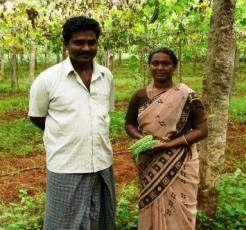
Nothing in this world is permanent and change is good. Sometimes a small change can make a big difference in your life.
Rajaram, from Kamachipuram village, Theni district owns three acres of land. He resides with his wife and a five year old son. Unlike any other farmer Rajaram had the same ground water issue which was holding him back in agriculture. Habitually, he cultivated less profitable crops due to scarce resources. After so much of loss he incurred in agriculture, Rajaram gave up and wanted to start a small plumbing accessory shop in his village. He scrutinized money by mortgaging his agriculture land with a local money lender and invested to begin a shop. This time also luck did not favor Rajaram; he was not making good business and was unable to repay the loan. Finally, caught in debt he was in a situation to sell his shop as well.
A few months before disposing his shop, Rajaram visited one of his friends in the next village. As he walked through the village to be with his friend, he came across a lush green field. Reluctantly, Rajaram approached the owner farmers and asked about the secret of his green field. There he learnt about the low cost drip irrigation system.
Rajaram went and met some other farmers who were already using similar drip systems. Talking with them gave him first-hand information about the product and he could clarify all his doubts. He thought this system would help him to save the available water and irrigate the land wisely but with too many debts already Rajaram was hesitant. Rajaram's friend helped him with money to install low cost drip system.
This time Rajaram did not want to invest in big or less profitable crops so he irrigated the land and cultivated native vegetables that bring good rates from the market. In his first harvest he made INR 10,000.
With the profit he met his wife's delivery expense. Rajaram is increasing the field under drip irrigation and with it also increasing the prosperity in his life.
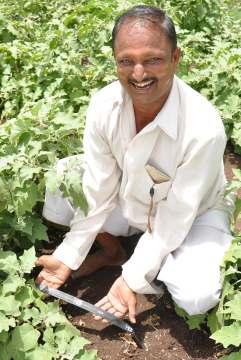
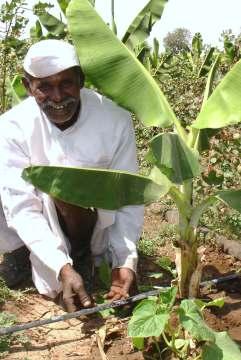

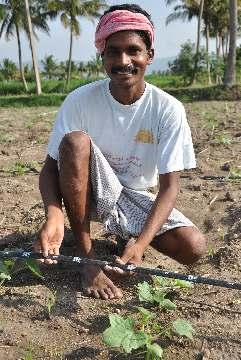
SUSTAINABLE AGRICULTURE
IDE-India recognizes that technology driven agriculture is just one of the ingredients needed to achieve sustainable rural livelihoods. Higher crop yields, reduced soil erosion, effective use of integrated fertilizer and pest management, for example by themselves are not enough. In order to identify different aspects IDEIndia has conducted a constraint analysis. The key constraints that emerged are illustrated and explained as below:
Constraints may occur at one of three levels in the commodity chains within which smallholders operate:
The input market - the enterprises and organizations that provide the goods, services, and information required for agricultural production. The on farm - the household production unit that consumes inputs to cultivate crops for self-consumption and for sale to output markets.
The output market - the enterprises and organizations that provide the goods, services, and information required to move the small farm production from field to consumers at economically rewarding prices.
Infrastructure - the physical and institutional infrastructure that facilitates market access and communication. Technology - the technologies required to increase smallholder productivity, deliver the necessary inputs, and move outputs to markets.
Policy - the policy environment within which smallholders and small enterprises operate, and

Information - timely and accurate market information to aid in decision making including crop prices, market opportunities, product standards, regulations, etc.
Constraints faced by smallholders
Finance - micro credit needs of smallholders and capital needs of enterprises that serve the smallholder market.
Capacity - The knowledge, skills and expertise of smallholders and the enterprises that serve them.
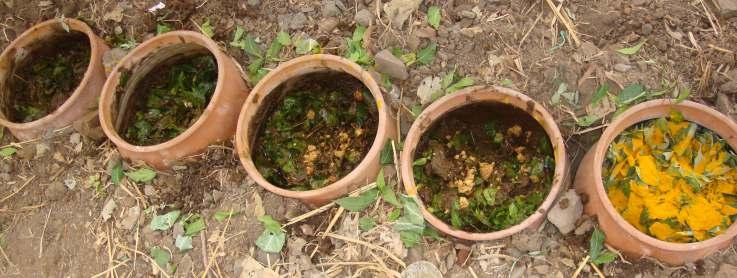
A thorough analysis of constraints at each market level and in each constraint category will normally result in a long and daunting list of market constraints. In order to limit and focus the potential areas of intervention, constraints are prioritized to identify the “key logs in the logjam” that can unleash growth potential for large numbers of smallholders. Such leverage points may be found by identifying nodes in the value chain where a small number of firms act as intermediaries for large numbers of smallholders, or by taking advantage of geographic clustering of similar enterprises or production systems, or by identifying policy levers that will remove constraints for many market actors at once. Constraints are ranked and prioritized based on the potential impact on smallholder income and the number of smallholders affected. Based on the understanding of the constraints, IDEIndia proposed to implement the model basis the following illustration:
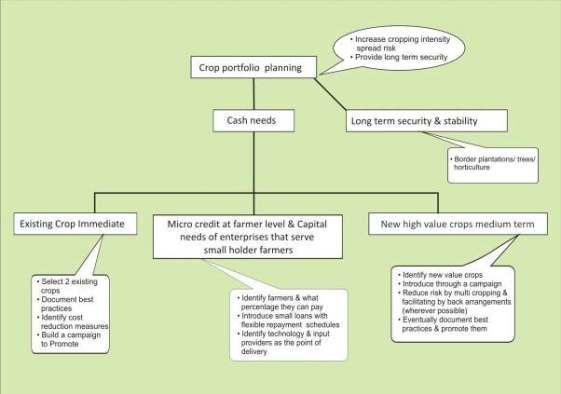
IDE-India has adopted the model of training local farmers and establishing a cadre of trained young people and women for delivery of this program. This will help build sustainability in the program. During the year, 53 new CWE were established. They have in turn reached out about 13, 179 farmers.
A SWEET BITTER GOURD!
Walking around a house construction site, it's tough to find the farmer Mr. Kumar Patel. But soon one person welcomes with a beaming smile and he is Mr. Patel.
Unable to hide his overwhelming joy, Mr. Patel quickly shared, “See I am able to make a pucca (concrete) house because of the income I generated with the bitter gourd cultivation. I always stayed away from this vegetable because of the pest problem. Most of the farmers struggled to keep the plant (of this crop) straight and free from the pests. But following the tips provided by the IDE-India team helped me to harvest a bumper crop. I cannot thank them enough.” Kumar with the harvestKumar Patel and his four-member family hails from Khariar block of Nuapada districts of Odisha. Owning about 1.60 acres of fragmented land was never a blessing and however hard he struggled he could never make his ends meet. His situation was exacerbated by sudden medical expenses and education related expenses for children. He was cultivating paddy on the major chunk of his land and few vegetables like eggplant, chilli and cowpea on the upland. Vegetables were cultivated for self-consumption only. Since he was not able to make enough money from crop cultivation, Kumar would often migrate out to generate additional income for better life however the results were disappointing.
Kumar learnt about bitter gourd cultivation through a farmer meeting where he learnt about advantages of cultivating bitter gourd. He was thrilled to hear that the crop had a good market value. The IDE-India team's updated knowledge about local markets and price trends gave him immense confidence that even a small farmer like him to cultivate bitter gourd. He was encouraged to cultivate it on quarter acre only and selected VNR-22 variety as that sold well in the market.
Kumar being a quick learner grasped the critical logjams for successful cultivation and learnt the importance of following the practices correctly. Although he was laughed at by other farmers, but he confidently raised a nursery for bitter gourd against the traditional practice of direct seed sowing, in late November. In the meanwhile, he made raised beds. In less than a month the saplings were ready to be transplanted. The IDEIndia team guided him to transplant them at a proper spacing and in a specific pattern. Although it seemed that it meant wasting lot of space however Kumar patiently followed what he was told. He understood that this would help in intercultural operations and will reduce labor requirement. As the plants started to grow, so did Kumar's confidence. The introduction of and meticulous setting up of trellis was a landmark milestone. As the plants continued to grow and twine around the trellis, Kumar's started to feel happy inside. He knew only good will come his way. The periodic use of vermi-wash along with sustainable agricultural products protected the plants from pests.
Following all the cultivation practices, Kumar generated net profit of INR 34, 760 from quarter acre of land.
As Kumar generated income from this bumper harvest, he was very motivated to cultivate vegetables on his other land for selling in the market. He increased vegetable cultivation to include tomato, beans, cauliflower, cabbage, ridge gourd and cucumber. He generated INR 34, 000 net profit by selling surplus vegetables.
His increased income is helping him manage household expenses and educational expenses of children better. He started the construction of a four-room concrete house and saved some money in local bank also.
A happy Kumar and his family are determined to continue to change their fortunes and lead better lives!
NOTE: under each of the above-mentioned program, farmer outreach/ adoption is mentioned. Each of the numbers of farmer house hold are mutually exclusive. To exemplify, farmers who adopt treadle pump or drip irrigation system do cultivate vegetable crops and so do farmers who fall under the Sustainable Agriculture program, however each of the numbers mentioned are exclusive of each other.
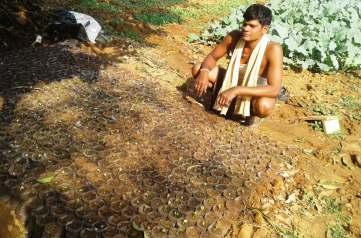
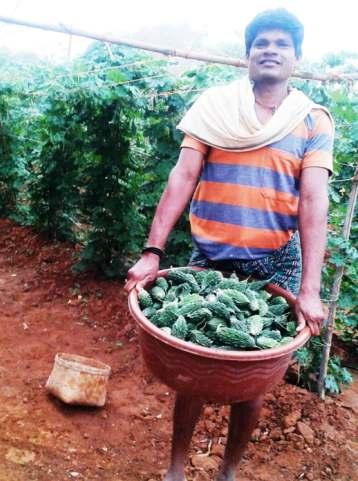
Kumar with the harvest
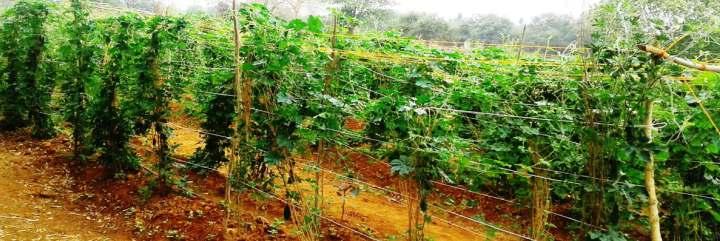
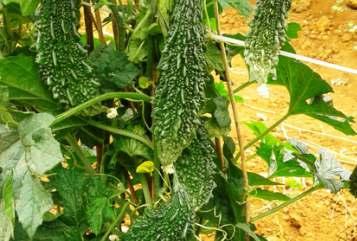
Kumar’s harvest
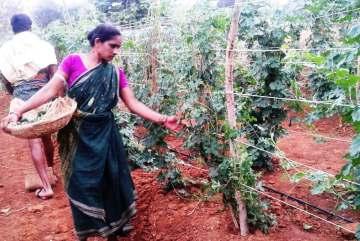
Nursery raised by Kumar
Trellis installed at Kumar's field
Kumar with his wife plucking the ripe fruit
SOCIAL RETURNS ON INVESTMENT
The start-up's receiving investments from social investors measure returns on investment along three parameters- primarily along Social Returns on Investment, followed by Environment Returns on Investment, followed by Financial Returns on Investment. This has been the trend for more than one decade. Now even the Indian stock market comes with Environment Returns on Investment which meets triple calculation.
We emphasise that neither we nor our donor community gets any financial returns, but the stakeholders namely, associated micro, small and medium enterprises get financial returns on investment directly or indirectly through employment generation, increased productivity and income. We monetize all the impact and present it below for better clarity.
Critical SROI that IDEI measures are as follows:
655 Million litres
Diesel Savings
817 Million kWh
Electricity Savings
6.17 Billion litres
Water Savings
2.46 Million tCO2 Eq.
Carbon Emission reduction
Employment
622 Million
person days
On Farm
1.14 Million
person days
Installation
0.63 Million
person days
Manufacturing
Income
31.1 Billion
On Farm
8 Million
Installation
63.8 Million
Manufacturing
INR 144.8 Billion
Farmer Income Generated
0.02 Million
person days
Retailer
15 Million
Retailer
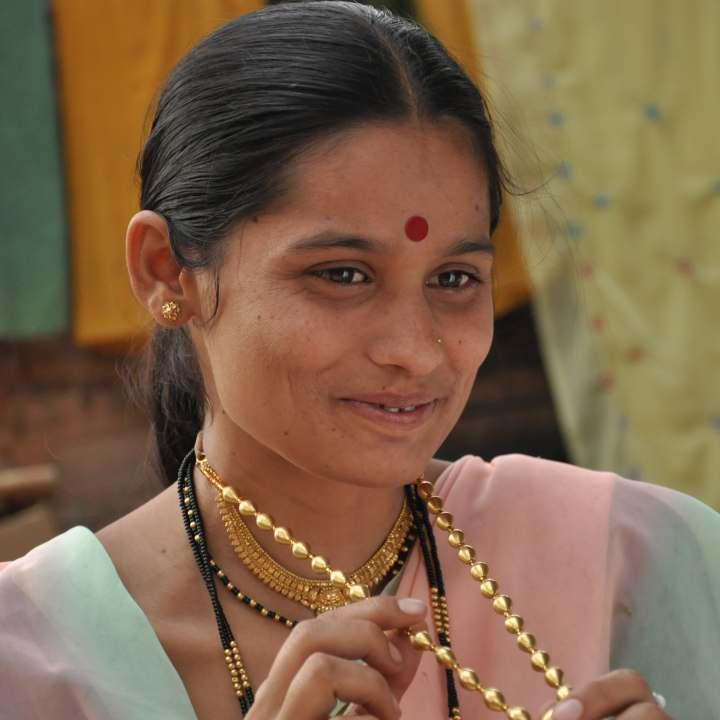
FINANCIAL EXCERPTS
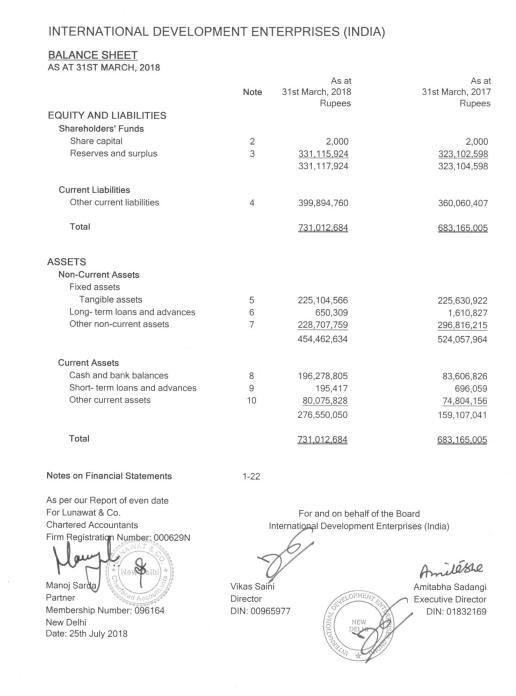
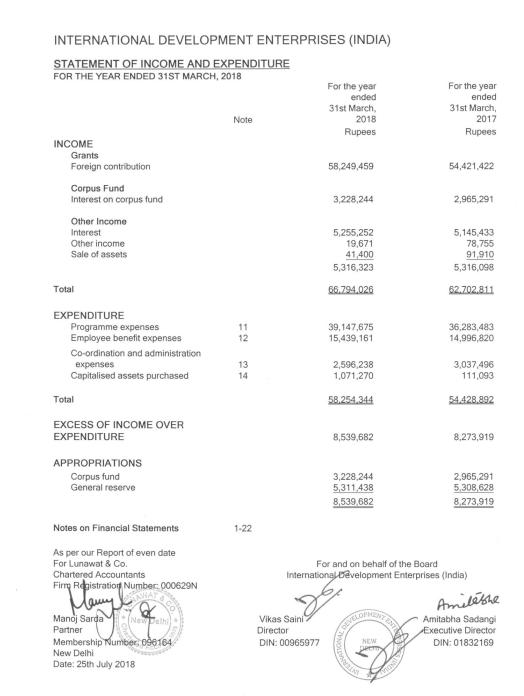
KNOWLEDGE PARTNERS
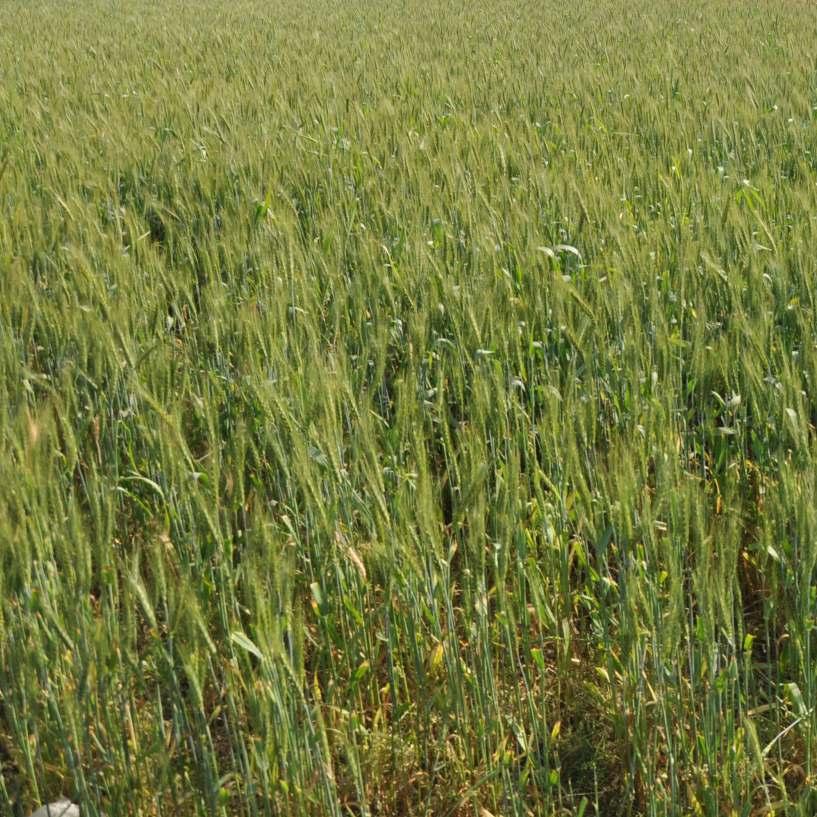
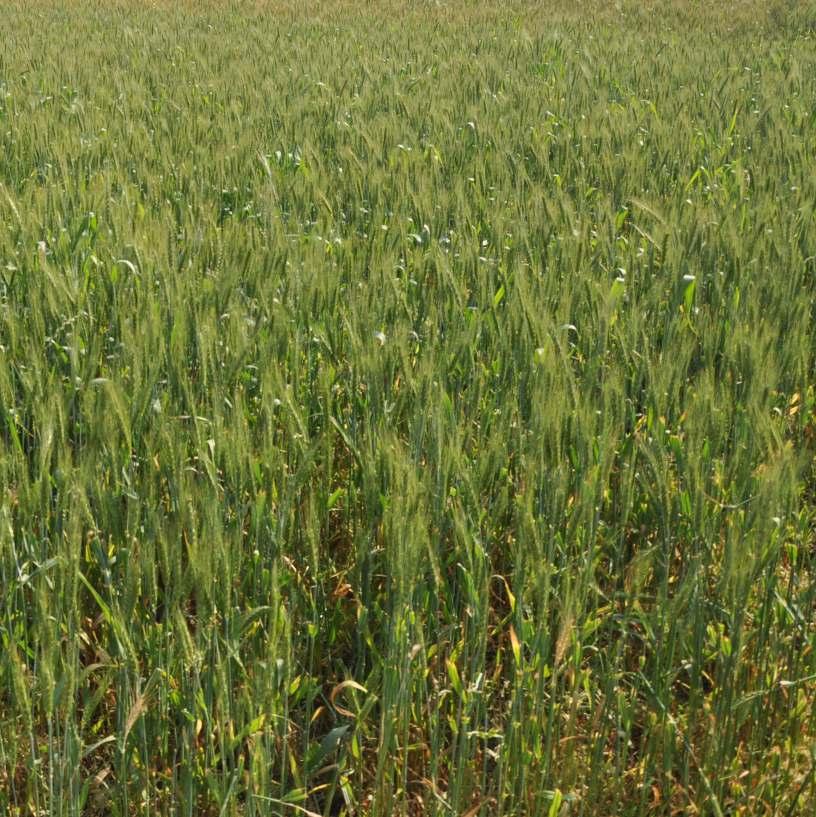
AWARDS AND ACCOLADES
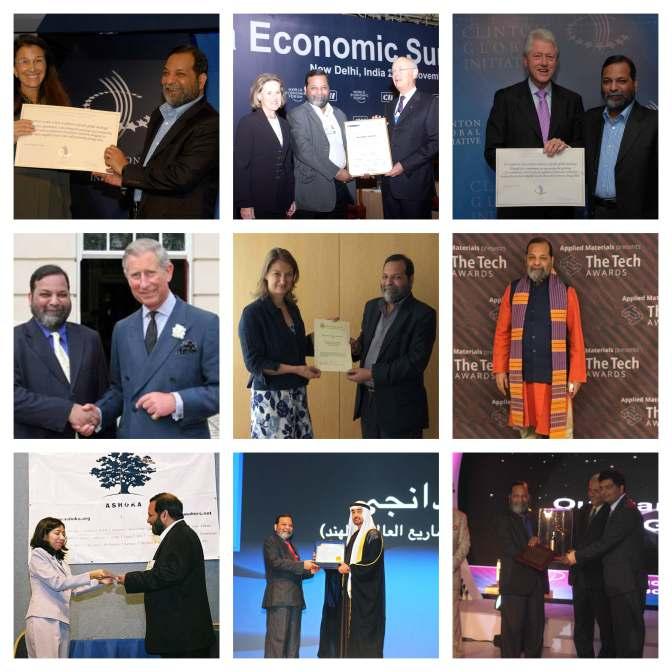

2010 - The Tech Awards Laureate
2010 - Zayed Future Energy Prize
2009 - Ashden Awards: Outstanding Achievement Award
2008 - Schwab Foundation: Outstanding Social Entrepreneur Award
2006 – Ashden Award for Sustainable Energy
2005 - Templeton Freedom Prize Award for Social Entrepreneurship
2005 - Skoll Foundation: Social Entrepreneur Award
2005 - Second Place In Most Innovative Project 2005
2004 - The Tech Awards Laureate
2004 - WTN Fellow For Social Entrepreneurship
International Development Enterprises (India) Plot No.10, Local Shopping Centre, Adjacent Bal Bhavan International School Sector-12, Dwarka, New Delhi - 110078





